#gaberdine
Explore tagged Tumblr posts
Text
Trinculo. Here's neither bush nor shrub, to bear off any weather at all, and another storm brewing; I hear it sing i' the wind: yond same black cloud, yond huge one, looks like a foul bombard that would shed his liquor. If it should thunder as it did before, I know not where to hide my head; yond same cloud cannot choose but fall by pailfuls. What have we here? a man or a fish? dead or alive? A fish: he smells like a fish; a very ancient and fish-like smell; a kind of not of the newest Poor-John. A strange fish! Were I in England now, as once I was, and had but this fish possible, not a holiday fool there but would give a piece of silver: there would this monster make a man; any strange beast there makes a man: when they will not give a doit to relieve a lame beggar, they will lay out ten to see a dead Indian. Legged, like a man! and his fins like arms! Warm o' my troth! I do now let loose my opinion; hold it no longer: this is no fish, but an islander, that hath lately suffered by a thunderbolt. [Thunder.] Alas, the storm is come again! my best way is to creep under his gaberdine; there is no other shelter hereabout: misery acquaints a man with strange bed-fellows. I will here shroud till the dregs of the storm be past.
William Shakespeare: The Complete Works, The Tempest (Act II, Scene II)
#book quotes#william shakespeare#the tempest#trinculo#bush#shrub#weather#wind#black cloud#rain clouds#stormy weather#questions#what have we here#fish#england#thunder#gaberdine#shelter#strange bedfellows
4 notes
·
View notes
Photo

. _______________________ 同社があるジョージア州で採れたコットンを用いたギャバジン織りのスラックス。 生地の仕上げはシルキータッチで非常になめらか。通気性もよく、アメリカのコットンらしいドライな肌触りです。 シルエットはオリジナルフィットという細身のシルエット。細身ながらお尻周りのゆとりは充分にとってあり、立ったり座ったりといった動きに違和感はありません。 腰裏は本格的な作り。バックポケットは両玉縁。前後ポケットの両端にはカンヌキ留めが施されています。 ※他にオリジナルフィットがあります。 <ブランド> アメリカはジョージア州にて、100年以上に渡って家族経営を���けているパンツ専業ブランド。上質なMADE IN USA製品を作ることで、地域の雇用を維持することを目的としています。デザインから発送までの全工程は、一貫してジョージア州トムソンの自社工場で行われています。All American Khakisは、AT&T、ニューヨーク交通局、米国空軍士官学校、海軍士官学校などのユニフォームの製造を請け負い、さらにはDィズニーワールドのユニフォームまで手掛けています。 . _______________________ . 詳細はプロフィールのリンクにある、オンラインストア、BLOGにてご覧いただけます。 @diaries_official 商品に関しての質問は、DMかメールにてお気軽にご質問ください。 . _______________________ . DIARIES 〒305-0031 茨城県つくば市吾妻3-8-17 TEL:029-875-7754 12:00-20:00 ※ただいま自粛中につき、短縮営業しています。18:30閉店です。(19時までは割といます。) (木曜定休・その他) https://diaries-shop.com #diaries #tsukuba #ibaraki #japan #ダイアリーズ #つくば #茨城 #日本 #セレクトショップ #AllAmericanKhakis #madeinUSA #Pants #Gaberdine #GeorgiaCotton #オールアメリカンカーキ #アメリカ製 #パンツ #スラックス #ギャバジン #両玉縁 #カンヌキ留め #アメカジ #アメトラ (Diaries / ダイアリーズ) https://www.instagram.com/p/Cpcif4SvUDy/?igshid=NGJjMDIxMWI=
#diaries#tsukuba#ibaraki#japan#ダイアリーズ#つくば#茨城#日本#セレクトショップ#allamericankhakis#madeinusa#pants#gaberdine#georgiacotton#オールアメリカンカーキ#アメリカ製#パンツ#スラックス#ギャバジン#両玉縁#カンヌキ留め#アメカジ#アメトラ
0 notes
Text

British fashion model Wenda Parkinson wears a Burberry loose raglan raincoat in mole wool gaberdine; matching rain hat. Lamb-lined overboots by Lilley & Skinner, Gloves, Fausta. For a feature entitled “Deep-Country Quality”, for British Vogue magazine, February 1951.
#vogue#british vogue#vogue uk#1950s#50s#fifties#vintage#vintage fashion#vintage vogue#1951#wenda parkinson#1950s fashion#1950s model#vintage model
487 notes
·
View notes
Text
just a few more "troublesome" words
fable, parable, allegory, myth
Fables and parables - stories intended to have instructional value.
They differ in that parables are always concerned with religious or ethical themes, while
fables are usually concerned with more practical considerations (and frequently have animals as the characters).
Allegory - an extended metaphor—that is, a narrative in which the principal characters represent things that are not explicitly stated.
Orwell’s Animal Farm is an allegory.
Myths - originally were stories designed to explain some belief or phenomenon, usually the exploits of superhuman beings.
Today, the word can signify any popular misconception or invented story.
florescent, fluorescent
Florescent - in flower
Fluorescent - radiating light
forbear, forebear
Forbear - (verb) to cease or refrain from
Forebear - (noun) ancestor
forceful, forcible, forced
Forcible - indicates the use of brute force (“forcible entry”).
Forceful - suggests a potential for force (“forceful argument,” “forceful personality”).
Forced - can be used for forcible (as in “forced entry”)
but more often is reserved for actions that are involuntary (“forced march”)
or that occur under strain (“forced laughter,” “forced landing”).
forego, forgo
Commonly confused, as here:
“The independents must destroy all documents obtained during the case and agree to forego any further litigation against the chains for three years” (International Herald Tribune).
Forego - means to go before, to precede.
To do without is to forgo.
former, latter
Former - properly used, should refer only to the 1st of 2 things
Latter - refers to the 2nd of 2 things
Both words, since they require the reader to hark back to an earlier reference, should be used sparingly and only when what they refer to is immediately evident.
fusion, fission
Both describe ways of producing nuclear energy:
Fusion - by fusing 2 light nuclei into a single, heavier nucleus
Fission - by splitting the nucleus of an atom
gabardine, gaberdine
Gabardine - a type of worsted cloth
Gaberdine - a long cloak
grisly, gristly, grizzly
Grisly - horrifying or gruesome
Gristly - applies to meat that is full of gristle
Grizzly - gray, especially gray-haired, and is a cliché when applied to old men
hanged
”It was disclosed that a young white official had been found hanged to death in his cell” (New York Times).
“Hanged to death” is a tautology.
So too, for that matter, are “starved to death” and “strangled to death.”
The writer was correct, however, in saying that the official had been found hanged and not hung.
People are hanged;
pictures and the like are hung.
harangue, tirade
A tirade - is always abusive and can be directed at one person or at several.
A harangue - need not be vituperative but may merely be prolonged and tedious.
It does, however, require at least two listeners.
One person cannot, properly speaking, harangue another.
heir apparent, heir presumptive
Heir apparent - inherits no matter what
Heir presumptive - inherits only if a nearer relation is not born first
impractical, impracticable, unpractical
If a thing could be done but isn’t worth doing, it is impractical or unpractical (the words mean the same).
If it can’t be done at all, it’s impracticable (the word means “incapable of being put into practice”).
in, into, in to
Generally, in indicates a fixed position (“she was in the house”)
while into indicates movement toward a fixed position (“she went into the house”).
There are, however, many exceptions (e.g., “she put the money in her pocket”).
As so often with idiom, there is no describable pattern to these exceptions; it is just the way it is.
Whether to write into as one word or two also sometimes causes problems.
The simple rule is that in to is correct when in is an adverb.
The distinction can perhaps best be seen in paired examples:
“He turned himself into [one word] an accomplished artist” but
“The criminal turned himself in to [two words] the police.”
Source ⚜ On Grammar & Vocabulary ⚜ Writing Basics & Refreshers
#writeblr#grammar#studyblr#langblr#linguistics#dark academia#vocabulary#light academia#writing prompt#literature#poetry#writers on tumblr#poets on tumblr#writing reference#spilled ink#creative writing#fiction#novel#writing resources
93 notes
·
View notes
Note
Hello!! I hope you're well! I was wondering if you have long-fics (5k+ words) where the husbands are kind of just. Pining??? 5+1 fics specifically? If it's not too much trouble. Although, even without the "5+1 things" tag, I would greatly appreciate it! Thank you so so much!! Have a great day :D
2/2: Hello again!! I am so sorry, I was the anon asking for the 5+1 & pining fics! I forgot to mention, please keep the spicy stuff away from the fic recommendations! I am incredibly sex-repulsed. Again, I apologize for forgetting to mention it in the last ask! Thank you kindly! So sorry for the inconvenience :(
Hi! Here are some 5+1 pining fics...
The Lovers, The Dreamers, and Me by ghosts_n_toast (T)
And so, Crowley devised a plan: he would go to the back room and lie down, but he wouldn’t actually sleep . And when Aziraphale, unsuspecting of his schemes, came to lean down and press another kiss to his forehead Crowley would…do something. He hadn’t figured that part out yet. Ask him where he got the nerve to treat him like a child at bedtime? Yell at him for trying to kiss unsuspecting sleeping people? Pull him back for another one? Kiss him on the forehead? The “after” part didn’t matter. What mattered now was catching Aziraphale in the act. - One night after a bout of heavy drinking, a half-asleep Crowley is kissed goodnight on the forehead by Aziraphale. What ensues is Crowley's terrible attempts to stay awake on the bookshop sofa to catch him in the act.
Points of Contact by cyankelpie (G)
Five times Crowley and Aziraphale found an excuse for physical contact, and one time they didn’t have to.
Do you have any idea by Enven (T)
He was hungry for anything he could get. Every tiniest scrap of attention Aziraphale gave him, everything that could at least potentially indicate that he enjoyed his company – Crowley would take it all, and shove it deep into the dimness of his mind to hopelessly reminisce about it later. or: 5 times they pined like crazy, and 1 time they didn't
Crowley's attempts at courtship (5+1) by p0psicle_ashtray (M)
The year is 1813, Crowley is currently in a gentlemen's club in Scotland when he runs into a familiar angel, they talk and Crowley realizes that he must do whatever it takes to make Aziraphale fall in love with him. He was going to court the pants right off him.
To Creep Under His Gaberdine by larkthorne (T)
Sharing a sleeping space used to be much more common, historically. It didn’t mean that Crowley and Aziraphale had (literally) slept together very often…but they had done so. By the middle of the 1800s or so that practice had fallen out of fashion, and it began to feel like a shocking sort of intimacy. Basically: five times Crowley and Aziraphale shared a bedtime before the Apocalypse, and the first time they shared a bedtime after.
What Are You Doing New Year's Eve? by theshoparoundthecorner (G)
“Bit of an odd tradition, if you ask me,” he said, if not to get his mind off the longing that had settled in his chest. Aziraphale shrugged. “I think it’s rather sweet. A kiss for good luck. Seems a nice way to start the year. Very human.” Crowley nodded. “Can’t seem to keep their hands off each other, that lot. Always finding excuses. First it’s mistletoe at Christmas, then it’s luck for the New Year…” “Well there’s no need to be so grouchy about it,” Aziraphale said. “I think it’s lovely.” Crowley’s heart ached a little more as he watched Aziraphale smile up at the glowing numbers on the building above them. Yeah, he thought, lovely. Five times Crowley thought about kissing Aziraphale on New Year's Eve, and one time he did.
- Mod D
65 notes
·
View notes
Text


Grimis Mort Jabot
A necktie jabot to add to any outfit to add a bit of *drama*.
Made for poly crepe fabric, gaberdine scrap fabric lining, polyester lace, and a scrap bit of antique velvet ribbon.
Available Now HERE
#gothic#victorian goth#romantic goth#dark academia#gothic lolita#victorian inspired#victorian mourning#thewidowshouse
24 notes
·
View notes
Text
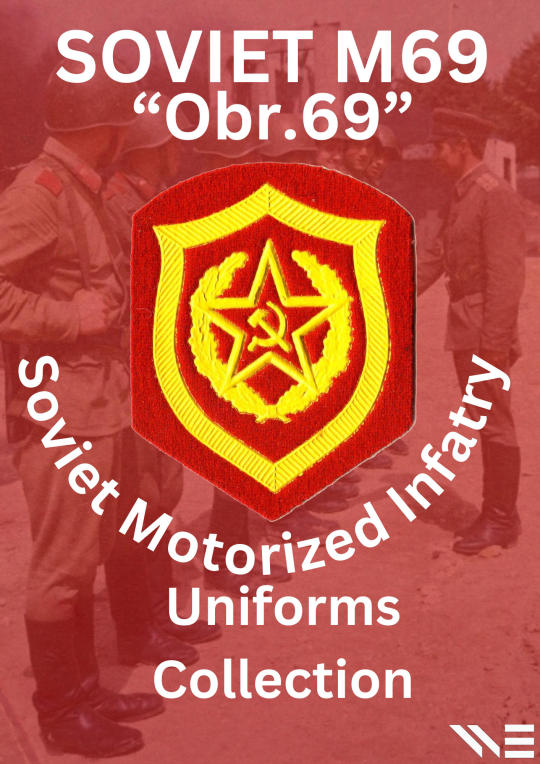
SOVIET M69 Uniforms Collection
DOWNLOAD
"Wishing you and your family a blessed Eid filled with love, happiness, and prosperity. May this Eid bring joy, laughter, and warmth to your life, and may you continue to be blessed with Allah's grace. Eid Mubarak!" -VVE Team
Disclaimer: Happy Eid-El Fitr, everyone! I'm glad to see our beloved customers once again. I must say, I've missed you all. My apologies for the long hiatus; March was not a good month for me. Aside from Ramadan, it took me a while to return to the game after my grandma's passing. I was fully devastated by the loss and felt hope fading away. But I realized I must stay strong and never give up hope. Anyway that's hella of Disclaimer tho.. So Let's Cut the Chase.
Tech Specs
Converted From "Call Of Duty:Black Ops Cold War" Credits belongs to Activision and Treyach Interactive
Most Set Got 7 Color Swatch (Most of Them Just A Rank From Lower to Highest)
Age Range: Teen-Elder
Male Only
Category:Costume
Some Color Swatches:

Overview
The M69 (Obr.69) uniform, part of the 1969 Uniform reforms for the Soviet Armed Forces, included Summer and Winter variants. Summer uniforms, made from M43/Obr.43 Gymnastyorka material, featured branch-specific insignia for garrison duty. In 1973, the uniform was updated with thicker cotton and "CA" shoulder boards. The Winter version, made from Wool Gaberdine, was worn with Ushanka hats and full insignia. Troops in hot climates had Tropical versions, and a Dress version was used for formal occasions. Standard until the late 1980s, it was eventually replaced by the M88/Obr.88 "Afghanka" pattern. I Must say it was My Personal Favorite Of Soviet Outfit After Gymnastyorka and Afghanka Despite This one Less Popular Than The two.
Battle Dress Uniform


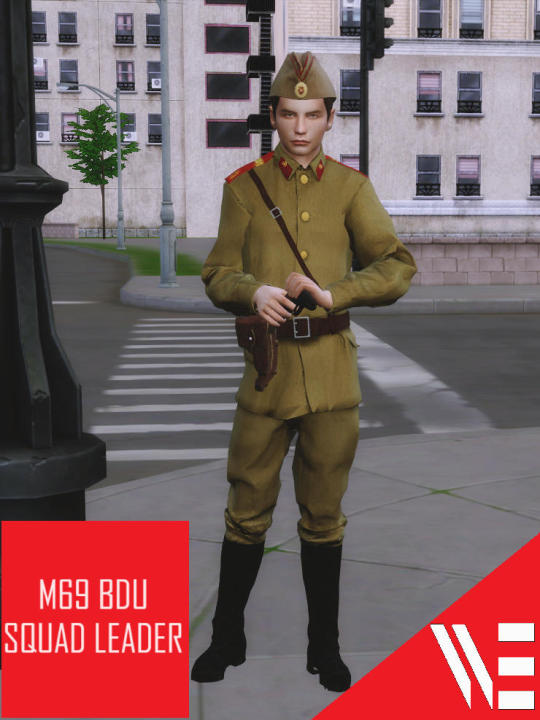
Base Uniform:Basically Just Regular Uniform, perfect for Non Combat Situation.
Strap-On:The regular Uniform With Tactical Strap. nothing special
Squad Leader: Uniform Used By Squad Leader at the Field. containing the Holster For Makarov Pistol (Thank you For @natalia-auditore For The Gun pose. I Love it)
Battle Configuration
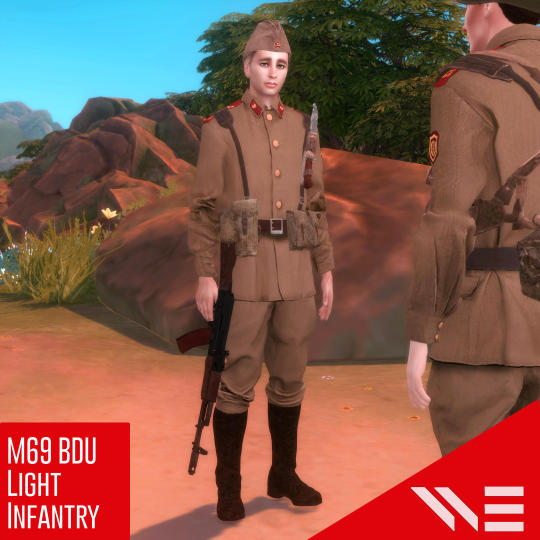


Light Configuration: Just Common Configuration that Most Soviet Soldier that Time Used. Only Contained the Essentials Such As AK Pouches and Some Grenade.
Afghan Set: This Set Particulary Used by Soviet Soldier During Soviet-Afghan War (1979-1989) Equipped by Poyas-A Tactical Pouches. such A Common Sights until it was Replaced by More Modern Afghanka M88.
Heavy Set: When Sheet Hit the Fan. in Case of Invasion of America The Soviet Troops are eqipped with more Sophicated Gears for ensuring the Winning the Battle
Officers
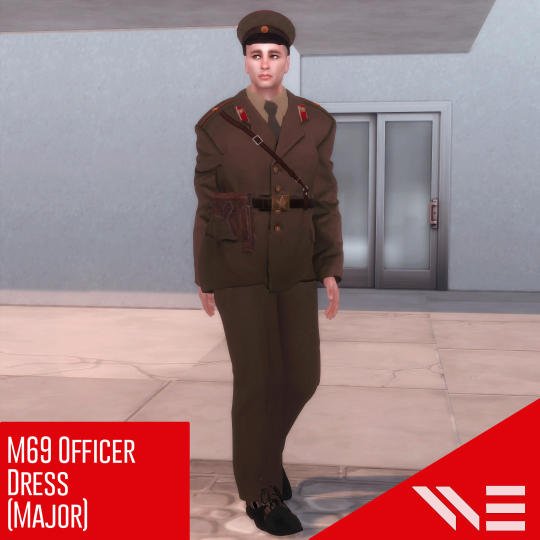
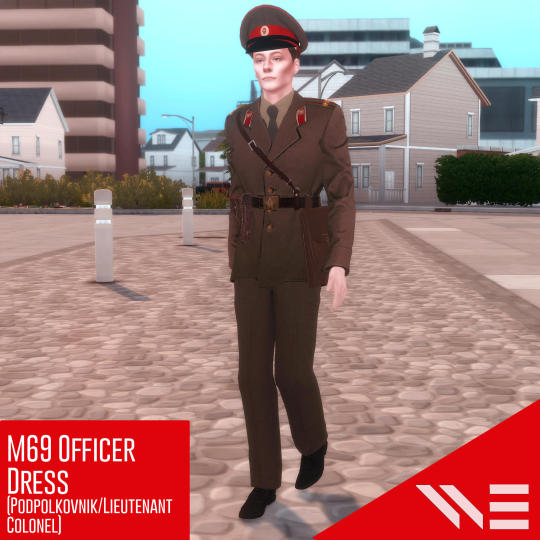

Some Officer Dress inside Soviet Army, It Actually appeared only Lieutenant Colonel. But I Edited the Mesh Myself To Expand more Variety
Majór (Major):One Star At Shoulder Board. Wearing Trousers. Equipped with Makarov Pistol's Holster Only
Podpolkóvnik (Lieutenant colonel):Two Star At Shoulder Board. Wearing Trousers. Equipped with Makarov Pistol's Holster & Map case
Polkóvnik (Colonel):Wearing Jodhpurs pants, Three Stars At Shoulder Board, Only Equipped with Makarov Pistol's Holster.
Specials
Standard Issue Winter Coat Used by Soviet Army During Cold War
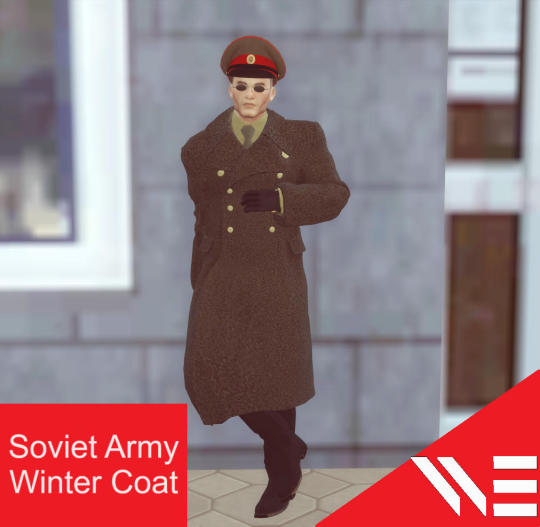
HEADWEAR
Thank you For @sarkana-sims For Lending some of Her OC to me for become A Showcasing Model!
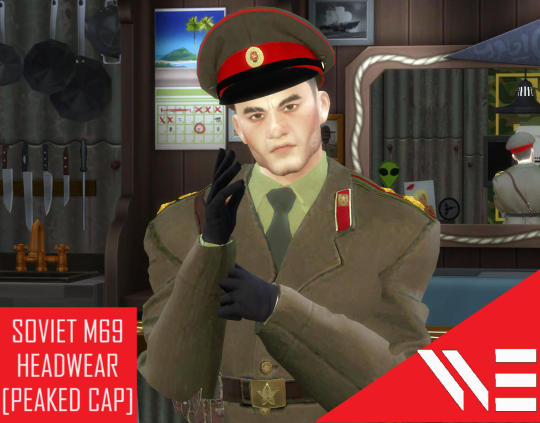
Soviet Army Peaked Cap: Intially worn just by Motorized Rifle generals, this pattern and color combination expanded in 1980 to include Medical, Veterinary, Intendance and Special Troops' generals. Externally virtually identical to a standard officer's service cap; it differs only in the all-gilt cockade and the general style buttons. Inspection of the inside construction - with its kid leather sweatband with interweaved ribbon, silk (or rayon) lining, and manufacturer's label - is a more certain means of identification. Note that you will sometimes see these general-grade caps with the standard officer cockade and star-embossed buttons, probably indicating use by colonels anticipating promotion! Although really any officer could wear these if they wanted to pay for the higher quality
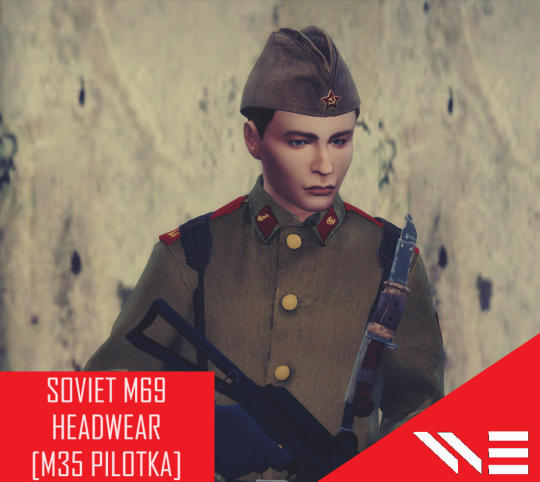
M35 Pilotka:The M35 Pilotka is a type of military cap used by the Soviet Union during the mid-20th century. It was introduced in 1935 and became a standard part of the Soviet uniform during World War II. The Pilotka features a soft, foldable design with a small visor at the front and is typically made of wool. It often included a red star insignia on the front to signify its Soviet origin. The Pilotka was worn by enlisted personnel and officers across various branches of the Soviet Armed Forces. Officers Variation Exist Featuring more Extravagants Insignia apart from Standard Red Star with Hammer & Sickle:
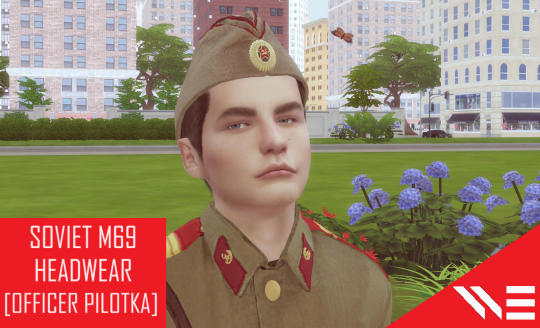
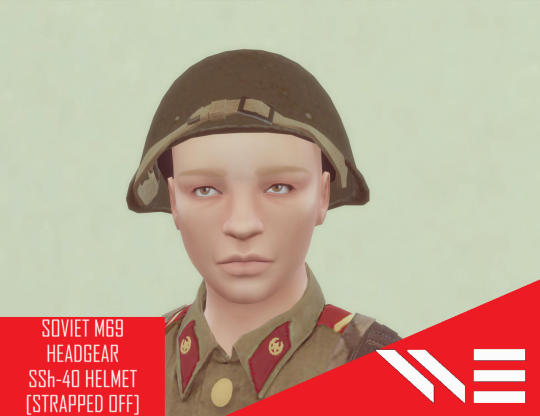
SSh-40 Combat Helmet: The SSh-40 is like the classic car of Soviet helmets, a true workhorse that saw action during World War II and beyond. It's that iconic steel dome-shaped headgear you often see in old war footage. Made of good ol' sturdy steel, it offered decent protection against shrapnel and small arms fire. Plus, it had those distinctive flared-out sides to cover your ears, giving you that unmistakable Soviet soldier look. It might not have been the most comfortable thing to wear, but hey, it did the job, and it looked badass while doing it. This Particular Model Is Got Strapped off Above the head.
Thank you!
@ts4history @ts4historyccfinds @sims4historicalccfinds @historicalsims4 @exzentra-reblog @exzentra
#the sims 4#the sims#the sims 4 custom content#ts4#ts4 cc#the sims 4 military#ts4military#the sim#the sims 4 cc#ts4cc#soviet union#call of duty#cod#call of duty cold war#cod cw#cod cold war#ts4 historical#ts4 outfits#ts4 cas#sims 4#ts4 simblr#the sims 4 uniform#ts4 military
30 notes
·
View notes
Text
Women of the Warsaw Ghetto
Keynote delivered in honor of Yom Hashoah, on the 80th anniversary of the Warsaw Ghetto Uprising. Event sponsored by the Jewish Federation of Dutchess County, New York.
The version of my talk below includes some pieces I had to edit out the live version for timing purposes. Majority of talk under a cut for reasons of: length, content relating to the mercy killing of children and the elderly, general genocide. I will also be posting a version of this talk to my instagram: @historicity_wasalreadytaken.
What I am about to read is an abridged version of Rachel Auerbach’s poem, “Yizkor, 1943,” translated from the original Yiddish, originally printed in David Roskies’ The Literature of Destruction: Jewish Responses to Catastrophe.
I saw a flood once in the mountains. Wooden huts, torn from their foundations were carried above the raging waters. One could still see lighted lamps in them; and men, women and children in their cradles were tied to the ceiling beams. Other huts were empty inside, but one could see a tangle of arms waving from the roof … At a distance, one could see mouths gaping, but one could not hear the cries because the roar of the waters drowned out everything.
And that's how the Jewish masses flowed to their destruction at the time of the deportations.
Sinking as helplessly into the deluge of destruction. And if, for even one of the days of my life, I should forget how I saw you then, my people, desperate and confused, delivered over to extinction, may all knowledge of me be forgotten and my name be cursed like that of those traitors who are unworthy to share your pain.
Who can render the stages of the dying of a people? Only the shudder of pity for oneself and for others. And again illusion: waiting for the chance miracle. The insane smile of hope in the eyes of the incurable patient. Ghastly reflections of color on the yellowed face of one who is condemned to death.
Condemned to death. Who could—who wished to understand such a thing? And who could have expected such a decree against … such low branches, such simple Jews. The lowly plants of the world. The sorts of people who would have lived out their lives without ever picking a quarrel with the righteous—or even the unrighteous—of this world. How could such people have been prepared to die in a gas chamber? The sorts of people who were terrified of a dentist's chair; who turned pale at the pulling of a tooth.
Even the sweetest ones: the two- and three-year-olds who seemed like newly hatched chicks tottering about on their weak legs. And even the slightly larger ones who could already talk. Who endlessly asked about the meanings of words ... Five-year-olds. And six- year-olds. And those who were older still—their eyes wide with curiosity about the whole world … Girls who still nursed their dolls off in corners. Who wore ribbons in their hair; girls, like sparrows, leaping about in courtyards and on garden paths … to whose cheeks the very first wind of summer seems to have given its first glowing caress. Girls of eleven, twelve, thirteen with the faces of angels.
And pious Jews in black gaberdines, looking like priests in their medieval garb: Jews who were rabbis, teachers who wanted to transform our earthly life into a long study of Torah and prayer to God. They were the first to feel the scorn of the butcher. Their constant talk of martyrdom turned out not to be mere empty words.
And still other Jews. Broad shouldered, deep voiced, with powerful hands and hearts. Artisans, workers. Wagon drivers, porters. Jews who, with a blow of their fists, could floor any hooligan who dared enter into their neighborhoods...You were swept away in the flood, together with those who were weak.
Grandfathers and grandmothers with an abundance of grandchildren. With hands like withered leaves … Who already trembled at the latter end of their days. They were not destined simply to decline wearily into their graves like rest-seeking souls; like the sun sinking wearily into the ocean's waves. No. It was decreed that before they died they would get to see the destruction of all that they had begotten; of all that they had built.
“I have so many names to recall, how can I leave any of them out, since nearly all of them went off to Belzec and Treblinka or were killed on the spot? … Absurd! I will utter no more names. They are all mine, all related. All who were killed. Who are no more. Those whom I knew and loved press on my memory, which I compare now to a cemetery. The only cemetery in which there are still indications that they once lived in this world ... I may neither groan nor weep. I may not draw attention to myself in the street. And I need to groan; I need to weep. Not four times a year. I feel the need to say Yizkor four times a day.
Remember, Oh Lord, the souls of those who passed from this world horribly, dying strange deaths before their time. And now, suddenly I seem to see myself as a child standing on a bench behind my mother who, along with my grandmother and my aunts, is praying before the east wall of the woman's section of the synagogue … And just then the Torah reader, Hersh's Meyer-Itsik, strikes the podium three times and cries out with a mighty voice … ‘We recite Yizkor.’
Auerbach composed this piece in November 1943, after the liquidation of the Warsaw Ghetto, after its Uprising, and after its destruction at the hands of the Nazis.
Born in 1903, Rachel Auerbach studied psychology at the University of Lwow. A talented and prolific writer, Rachel began her literary career in 1925, moving to Warsaw, home of the largest Jewish community in Europe, in 1933. She thrived there, among the city’s numerous theaters, publishing houses, cafes, art galleries, libraries, and museums; and socialized with the city’s Jewish intellectual elite.
When Poland fell to the Nazis in September 1939, Jewish historian Emmanuel Ringelblum recruited Rachel into the Aleynhilf, the Jewish “Self-Help” Organization of the Warsaw Ghetto. Ringelblum put Rachel in charge of a soup kitchen, a position which allowed her to observe a wide swathe of the ghetto’s inhabitants. In 1941, Ringelblum recruited Rachel into the Oyneg Shabbes, or “Pleasure of the Sabbath,” his underground group dedicated to documenting life in the Warsaw Ghetto as it happened, without analysis or commentary. He asked Rachel to write for the archive regular reports on her experiences in the soup kitchen.
In both these reports and her post-war writings, Auerbach described the ordinary people she worked with each day at that soup kitchen on Leszno Street. There was the efficient bookkeeper, Halina Gelblum, whose competence soothed the nerves of the rest of the staff. There was the sixteen-year-old Henie, who was always smiling and flirting with the boys who worked in the kitchen. There was Gutchke the cook; talented, yet often at odds with Auerbach’s fastidious approach to hygiene. She would sing to herself in Yiddish as she bustled about the kitchen, talk to the pots and pans, and test the soup with her fingers.
There was Dama, a once-wealthy woman who, as Auerbach wrote, had “been wearing for many weeks a black georgette cocktail dress, dragged down at the bottom in uneven tails, the seams plastered with nits; on her head a cloth jockey cap, yellow with brown strips, perhaps from some skiing costume; and over her shoulders, weighing her down, inseparable collections of large bags and small handbags stuffed with what few possessions she has left.”
Ringleblum so valued Rachel’s reports that he soon gave her additional assignments. One of these, was to conduct interviews with those who had escaped from the Treblinka death camp and returned to the ghetto. These escapees were brought to the attention of the Oyneg Shabbes through the work of two young female underground couriers: Chavka Folman, and Frumka Plotnicka—who once smuggled grenades, hidden in a basket of potatoes, into the Warsaw Ghetto. Those interviews became critical to alerting the outside world of the extermination of Polish Jewry.
After the War, Rachel—with fellow Oyneg Shabbes survivors Hirsch and Bluma Wasser—was critical to the recovery of the archive, which the Oyneg Shabbes buried beneath the ghetto in summer 1942, when the Nazis liquidated the Warsaw Ghetto, rounding up 90% of its inhabitants, over 300,000 individuals, and sending them by cattle-cars to their deaths at Treblinka. In April 1946, at a meeting held to commemorate the Warsaw Ghetto Uprising on its third anniversary, Auerbach—the only female speaker present—stood up, and said:
“We cannot rest until we dig up the archive. Even if there are five stories of ruins, we have to find the archive … I will not rest, and I will not let you rest. We must rescue the Ringelblum Archive!”
Eventually, through her persistence, and assistance from the Jewish Labor Committee in New York, the search began that summer, 1946. Thanks to Rachel Auerbach, the majority of the archive was recovered from beneath the ruins of the Warsaw Ghetto, and would become one of the most vital sources on daily life therein.
The Aleynhilf was not the only organization of its kind operating in the Warsaw Ghetto. Most homes in Warsaw were built in clusters of four, with a shared courtyard between them. During the initial occupation of the city, and the first months of the Ghetto’s existence, “house committees” began to emerge in these courtyards. The house committees provided to the clusters’ residents child-care, communal kitchens, and illegal educational and cultural activities. By April 1940, there were 778 house committees operating in the Warsaw Ghetto; by early 1942 there were 1,108, with 7,500 members between them.
One such member was a young woman named Hannah Fryshdorf, who would go on to fight in the Warsaw Ghetto Uprising, and escape the burning ghetto through the sewers under the leadership of Zivia Lubetkin, the highest-ranking woman in the Jewish Fighting Organization. In an abridged section of a talk she delivered after the war, “Memories of the Warsaw Ghetto,” Hannah briefly discussed the illegal educational activities conducted by the house committees; activities in which she took part. This source was provided to me by Hannah’s niece, Ettie Goldwasser; according to Goldwasser, this is the only public statement Hannah ever made about her experiences in the Holocaust.
She wrote:
What has not been spoken of is the important role the hoyf (courtyard) played in the life of the ghetto … Because the police curfew began at 6 p.m., effectively prohibiting anyone from leaving the apartment after that hour, life within the confines of the four hoyf walls took on unprecedented significance.
Let Genshe 33 serve as an example … Before the war some eighty families lived in this building. Though acquainted with one another, they did not socialize much. But during the ghetto years, over one thousand people—those who had been driven out of nearby neighborhoods and those who had originally lived in Warsaw outside the ghetto walls—were crammed into the building.
When curfew fell at 6 p.m. and the gates closed, people, including children, began gathering in the hoyf to walk around until late into the night. In the courtyard they exchanged news about daily life, discussed the miracle of surviving yet another day, and gave voice to rumors true and false, recounting them over and over. Gradually, the inhabitants of the hoyf became more and more intimately connected, and the hoyf itself actually became a shtetl.
Quite naturally there arose a wish for an organized cooperative way of life, and…it fell to a group of the older activists to organize and create a hoyf committee. The organizers felt that it was their responsibility to look after the spiritual and bodily well-being of those who lived within the hoyf's quarters.
The first job was to raise money for feeding the hungry, since there were people close to starvation. It was difficult, yet funds were found and a soup kitchen was started. Every day several women volunteered to work there, cooking and serving supper … One good meal a day saved dozens of families from starvation.
Some 40 teenagers would meet every evening in a small room and spend several hours together, talking, discussing, reading books … For a few hours each night they were able to forget their cares and their hunger; for a few hours they were young again. And these same youngsters took it upon themselves to be concerned with those even younger, helping them to live a little, making them laugh, sing, and play.
So a ‘children’s corner’ was created, a kind of ghetto school. During the day it accommodated the smaller children, and at night the 18-year-olds. And it was terribly hard work to deal with shivering and starving children in a cold unheated room for six or seven hours a day. How much ingenuity and effort were summoned by untrained teachers to keep the children interested, to keep them from running out into the streets to grab or steal something to eat. And what strength it took for the teachers, cold and hungry themselves, to stand for hours at a time, teaching kids between six and thirteen, in one room without educational materials, without toys.
But they accomplished their aims … Both teacher and student knew what awaited them should they be caught attending this clandestine school, but fear held no one back; no child gave up his or her place.
… Back then we put in so much of our heart and hard work; and this was a time when hundreds of people were dying of starvation and illness, when not a single household was without a member stricken by typhus … a time when the Germans snatched people off the street for work details and dragged young men from their beds at night … At this moment when energies were being depleted, it became important to find comfort, to give each other hope.
These house committees quickly became the center of public life in the Warsaw Ghetto. And more often than not, these committees were managed and staffed by female volunteers. And for most of these women, this was the first time in their lives that they were able to step into leadership roles. Many of them thrived, finding within themselves strength which they had never before had reason to access.
However, this change in women’s traditional behavior went beyond the confines of the courtyard. One such process is illustrated in the recollections of Feigele Peltel, better known to the world as Vladka Meed, a courier and arms-smuggler for the Jewish resistance, and later, a Holocaust educator.
During the siege of Warsaw in September 1939, the Jews and the Poles experienced a brief moment of unity as they rushed to their city’s defense. Yet, the food, water, gas, and electric shortages which accompanied the German siege put a quick end to this showing of camaraderie. As the Germans marched into the city, they fanned the flames of Polish anti-Semitism. For example, as they set up soup and bread lines for Polish civilians, they encouraged the Poles to drive Jews out of the lines with such statements as: “the Jews deprive the Poles of their spoonful of soup!”
On September 28, 1939, a cheerful Jewish man named Shlomo Peltel was standing in one of these lines. He’d encountered German soldiers during their occupation of the city in World War I, and had found them to be friendly and courteous. But, as he stood on that bread line, the Poles around him began to mutter that he was a Jew. As their mutterings grew louder, a German soldier grabbed Shlomo, pulled him roughly out of the line, and beat him. According to Feigele, his oldest daughter, this experience was traumatic for Shlomo, and, afterwards, he retreated into the family home “a broken man,” no longer able to support, provide for, or protect the family as he had in the days before the occupation.
Before the war, Shlomo had owned a modest haberdashery. When the store was struck by a German bomb in the early days of the invasion, the Peltels were able to salvage some of the merchandise; merchandise, which could be sold for cash on the black market. Those sorts of transactions, however, were only conducted in the parts of the city declared off-limits to Jews. The shattered Shlomo certainly couldn’t undertake such a mission, but Feigele, a Bundist activist with features more Aryan than Jewish, certainly could. And so, Feigele loaded up their wares, sold them on the black market, stood in the breadlines, and just like that, took on the role of family provider.
Shlomo was not alone. Finding themselves unable to act as breadwinners and protectors, Jewish men struggled, and often, failed to adapt, leaving their wives and daughters to support the family.
Further, men were the typical targets of Nazi forced labor round-ups. German gangs would seize Jewish men at random, and force them to engage in all manner of labor—from road construction to forest clearance—typically designed to exhaust even the most physically fit of men. These forced laborers were subject to random and brutal violence, and many died from a combination of exhaustion, hunger, heart failure, and exposure. As husbands, fathers, sons, and brothers returned from work assignments sick, beaten, and traumatized, and retreated into the home, their wives, mothers, daughters, and sisters emerged from its confines. As Emmanuel Ringelblum wrote in his diary:
Women’s perseverance—the main providers. Men don’t go out. When [a man is seized for forced labor], the wife does not let go. She runs after [the kidnappers], she screams and cries ‘please, Mister’—she is not afraid of the soldiers. She stands on the long line—some are seized to work … The beautiful hats have disappeared. In wartime [women] put on scarves. When there is need to go to [the Gestapo] the daughter or wife goes; in the worst scenario they stand and wait in the hallway … The women are everywhere since the [men] have been taken to all sorts of work … When a husband escapes … his wife has to be the sole provider. [Women] who never thought of working [out of their homes] are now performing the most difficult physical work.
While women expressed satisfaction, and indeed, newfound empowerment, with their new roles and responsibilities, the enforced starvation, terror, and poverty of daily life in the Warsaw Ghetto took their toll. Women abandoned their children on the front steps of orphanages and self-help institutions, in the hopes that there, their children might have a chance at survival. Some women worked as smugglers and prostitutes to provide for their families, often with the tacit approval of their husbands and parents. Once-wealthy women took work as house-cleaners, while female nurses and doctors worked relentlessly at the impossible task of containing the typhus, dysentery, and tuberculosis outbreaks which plagued the ghetto.
Some of these doctors and nurses described their own attempts to shield their patients from pain and suffering, even as the Nazis were forcing Jews onto the cattle cars which would bear them to their deaths. In her memoir, I Remember, Nothing More, Dr. Adina Blady-Szwajger recalled:
… Sister Mira came for me—I can’t remember her last name but I still see her face in front of me as if she were here now. And she asked me to go downstairs with her for a moment. When we left the ward, she said—and I can still hear this — ‘Doctor, please give my mother an injection. I can’t do it. I beg you, please. I don’t want them to shoot her in bed, and she can’t walk.’ So I asked her what was in the syringe and she told me it was morphine.
… We went to the first floor where the families of staff were ... And so, that grey-haired lady smiled at me and stretched out her arm. The sister put on the clamp. And I injected the morphine into her vein. And then I saw a few more people who didn’t have the strength to move. I asked Mira what we should do and she said: ‘Help them, surely.’ So we helped them, too. And by the window there was this woman, swollen from starvation, and suffering from circulatory insufficiency, and she kept on looking at us, pleading with her eyes. She was the last one we gave an injection to.
… When I left the room, I held out my hand and got two large containers of morphine. We didn’t say a word to each other, just squeezed each other’s hands, I think.
I took the morphine upstairs. Dr. Margolis was there and I told her what I wanted to do. So we took a spoon and went to the infants’ room. And just as, during those two years of real work in the hospital, I had bent down over the little beds, so now I poured this last medicine into those tiny mouths. Only Dr. Margolis was with me. And downstairs, there was screaming, because the…Germans were already there, taking the sick from the wards to the cattle trucks.
After that we went in to the older children and told them that this medicine was going to make their pain disappear. They believed us, and drank the required amount from the glass. And then I told them to undress, get into bed and sleep. So they lay down and after a few minutes—I don’t know how many—but the next time I went into that room, they were asleep. And then, I don’t know what happened.
These ordinary women rose to meet circumstances unimaginable to them even two years earlier. Their resistance was not of the military variety that comes to mind when we discuss the concept of resistance, but each act; each dose administered; each child taught; each person allowed to live one more day, was an act of resistance.
There were women in the Warsaw Ghetto who did engage in resistance as we typically think of it: as fighters, arms smugglers, spies, and commanders. And, despite what 80 years of novels, comic books, films, and theater would have us think, women were present and vital at every stage of the Warsaw Ghetto Uprising. I have already mentioned several of these women: couriers and arms smugglers Chavka Folman, Frumka Plotnicka, Hannah Fryshdorf, Zivia Lubetkin, and Vladka Meed.
The female couriers acquired guns, explosives, and ammunitions, smuggled them past the German guards, and into the Ghetto. They slept with chemical explosives and instructions for the manufacture of homemade bombs under their pillows, and smuggled dynamite into the ghetto through labyrinthine passageways of the factories which abutted the Ghetto.
In her memoir They Are Still with Me, Chavka Folman wrote of one such mission:
For a short while I lived in the same room with Tema Schneiderman … Under the bed was … a suitcase containing pistols and grenades … Tema and I brought the grenades to the ghetto ... Each of the girls hid a grenade in her most intimate place, her undergarments. From a suburb of the city we took a streetcar in the direction of the ghetto. I recall our odd behavior during the ride. Tema stood at my side and asked: ‘What would happen if a gentleman invited us to sit beside him?’ We broke into laughter; hiding our fear in this way…
Jewish Fighting Organization commander Yitzak “Antek” Zuckerman wrote that he would never forget the celebration which took place in honor of courier Frumka Plotnitcka when she smuggled the Jewish Fighting Organization’s first weapons acquisition—those basketed grenades—into the Warsaw Ghetto.
Stories such as these proliferate through the diaries, memoirs, autobiographies, and testimonies of surviving members of the Jewish Fighting Organization. Male and female resistance leaders alike made it very clear in their post-war writings and testimonies that no uprising could have happened without the women, many of whom were discovered, tortured, and murdered over the course of their missions. Indeed, a courier named Hasia began her underground work in a group of 23 women. Only five survived.
When the Warsaw Ghetto Uprising began on April 19, 1943, women served as sharpshooters, reconnaissance officers, fighters, and commanders.
Today, the 27th of Nisan, is the day of Yom HaShoah, as set by the Israeli Parliament in 1953 to align with the events of the Warsaw Ghetto Uprising. Today, as we approach the 80th anniversary of that Uprising, we remember these women of the Warsaw Ghetto; their courage, their loss, and their resistance.
Thank you.
61 notes
·
View notes
Text
ive been listening to no children non stop since watching that episode im pretty sure i can memorise the lyrics at this point, it’s not healthy
spoilers
and nature is too real man, orel’s flinches and his movements are wayyy too accurate when clay is going on that rampage AND THE WAY TEARS WELLS UP IN HIS EYES BUT HE DIDNT ACTUALLY CRY and WHEN CLAY RIPPED HIS SHIRT HES SO PASSIVE ABOUT IT legit reliving my trauma goddamn to say it shook me to the core is an understatement
the cinematography is also so gd wtf??? the dream sequence and when clay was walking towards the family pic and heard oral asking bloberta why she married him, i honestly want to try claymation after watching that absolute masterpiece
moral orel stepped on me, spat on me, shat on me and left me to suffer like how Antonio ‘you call me a misbeliever, cut-throat dog and spit upon my Jewish gaberdine’ to Shylock and no children is haunting my soul constantly, terrorising me to wits end but also it’s so good wtf? this has to be illegal
im literally going insane
#moral orel#orel puppington#clay puppington#is breaking my heart#shaking my confidence daily#no children#moral orel rant#spoilers
9 notes
·
View notes
Text
I'm drooling over a fabric that isn't brocade or gaberdine for a change.
My teenage self would be horrified at me.





62K notes
·
View notes
Link
Check out this listing I just added to my Poshmark closet: Plein Sud Wool/Silk Gaberdine Blazer.
0 notes
Photo

A male model wearing a custom-tailored gaberdine suit by Felice di Pino with a Nehru collar, Leonard Nones, 1968
#Leonard Nones#60s#vintage#vintage fashion#menswear#tailoring#vintage photography#fashion photography
0 notes
Photo
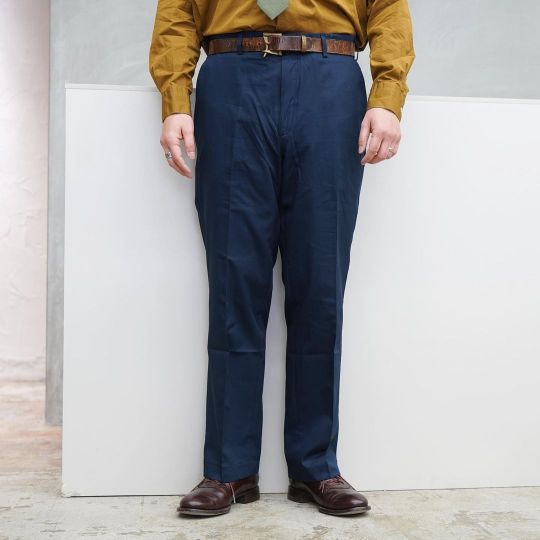
. _______________________ 同社があるジョージア州で採れたコットンを用いたギャバジン織りのスラックス。 生地の仕上げはシルキータッチで非常になめらか。通気性もよく、アメリカのコットンらしいドライな肌触りです。 シルエットはオリジナルフィットという細身のシルエット。細身ながらお尻周りのゆとりは充分にとってあり、立ったり座ったりといった動きに違和感はありません。 腰裏は本格的な作り。バックポケットは両玉縁。前後ポケットの両端にはカンヌキ留めが施されています。 ※他にオリジナルフィットがあります。 <ブランド> アメリカはジョージア州にて、100年以上に渡って家族経営を続けているパンツ専業ブランド。上質なMADE IN USA製品を作ることで、地域の雇用を維持することを目的としています。デザインから発送までの全工程は、一貫してジョージア州トムソンの自社工場で行われています。All American Khakisは、AT&T、ニューヨーク交通局、米国空軍士官学校、海軍士官学校などのユニフォームの製造を請け負い、さらにはDィズニーワールドのユニフォームまで手掛けています。 . _______________________ . 詳細はプロフィールのリンクにある、オンラインストア、BLOGにてご覧いただけます。 @diaries_official 商品に関しての質問は、DMかメールにてお気軽にご質問ください。 . _______________________ . DIARIES 〒305-0031 茨城県つくば市吾妻3-8-17 TEL:029-875-7754 12:00-20:00 ※ただいま自粛中につき、短縮営業しています。18:30閉店です。(19時までは割といます。) (木曜定休・その他) https://diaries-shop.com #diaries #tsukuba #ibaraki #japan #ダイアリーズ #つくば #茨城 #日本 #セレクトショップ #AllAmericanKhakis #madeinUSA #Pants #Gaberdine #GeorgiaCotton #オールアメリカンカーキ #アメリカ製 #パンツ #スラックス #ギャバジン #両玉縁 #カンヌキ留め #アメカジ #アメトラ (Diaries / ダイアリーズ) https://www.instagram.com/p/Cpch_k6Pd0N/?igshid=NGJjMDIxMWI=
#diaries#tsukuba#ibaraki#japan#ダイアリーズ#つくば#茨城#日本#セレクトショップ#allamericankhakis#madeinusa#pants#gaberdine#georgiacotton#オールアメリカンカーキ#アメリカ製#パンツ#スラックス#ギャバジン#両玉縁#カンヌキ留め#アメカジ#アメトラ
0 notes
Text
A poem by Edwin Morgan

In the Snack-bar
A cup capsizes along the formica, slithering with a dull clatter. A few heads turn in the crowded evening snack-bar. An old man is trying to get to his feet from the low round stool fixed to the floor. Slowly he levers himself up, his hands have no power. He is up as far as he can get. The dismal hump looming over him forces his head down. He stands in his stained beltless gaberdine like a monstrous animal caught in a tent in some story. He sways slightly, the face not seen, bent down in shadow under his cap. Even on his feet he is staring at the floor or would be, if he could see. I notice now his stick, once painted white but scuffed and muddy, hanging from his right arm. Long blind, hunchback born, half paralysed he stands fumbling with the stick and speaks: ‘I want – to go to the – toilet.’
It is down two flights of stairs, but we go. I take his arm. ‘Give me – your arm – it’s better,’ he says. Inch by inch we drift towards the stairs. A few yards of floor are like a landscape to be negotiated, in the slow setting out time has almost stopped. I concentrate my life to his: crunch of spilt sugar, slidy puddle from the night’s umbrellas, table edges, people’s feet, hiss of the coffee-machine, voices and laughter, smell of a cigar, hamburgers, wet coats steaming, and the slow dangerous inches to the stairs. I put his right hand on the rail and take his stick. He clings to me. The stick is in his left hand, probing the treads. I guide his arm and tell him the steps. And slowly we go down. And slowly we go down. White tiles and mirrors at last. He shambles uncouth into the clinical gleam. I set him in position, stand behind him and wait with his stick. His brooding reflection darkens the mirror but the trickle of his water is thin and slow, an old man’s apology for living. Painful ages to close his trousers and coat – I do up the last buttons for him. He asks doubtfully, ‘Can I – wash my hands?’ I fill the basin, clasp his soft fingers round the soap. He washes, feebly, patiently. There is no towel. I press the pedal of the drier, draw his hands gently into the roar of the hot air. But he cannot rub them together, drags out a handkerchief to finish. He is glad to leave the contraption, and face the stairs. He climbs, and steadily enough. He climbs, we climb. He climbs with many pauses but with that one persisting patience of the undefeated which is the nature of man when all is said. And slowly we go up. And slowly we go up. The faltering, unfaltering steps take him at last to the door across that endless, yet not endless waste of floor. I watch him helped on a bus. It shudders off in the rain. The conductor bends to hear where he wants to go.
Wherever he could go it would be dark and yet he must trust men. Without embarrassment or shame he must announce his most pitiful needs in a public place. No one sees his face. Does he know how frightening he is in his strangeness under his mountainous coat, his hands like wet leaves stuck to the half-white stick? His life depends on many who would evade him. But he cannot reckon up the chances, having one thing to do, to haul his blind hump through these rains of August. Dear Christ, to be born for this!

Edwin Morgan (1920 – 2010)
More poems by Edwin Morgan are available on the Scottish Poetry Library site.
1 note
·
View note
Text
TAKE TWO: CALLING ALL FREAKS, GEEKS, BABES, BAD BOYS, AND EVERYTHING IN BETWEEN!
"The name is Gabrielle Gaberdine - gabby Gabby if you're nasty - and I'm so at your service to say that it's another daring, music-blaring, crowd is roaring, can't-be-boring kind of night in Port Manteau! The peeps are out to party, and trust me when I say that the glitter-soaked-scumbags around here know how to rage. I hear it's a rave at Suds tonight, afters at the Redlight - maybe we'll even watch the sunrise off the rooftop if everyone's got enough wits left to stumble up the stairs, so... Let me know if you need an invite, yeah? Like, everyone who's anyone is gonna be there."

"We’ve got about half of our party filled at the moment, and I'd hate to see you miss out on your first night in New Zeppelin... So, check it out, yeah?”
0 notes
Text
ONCE IN ’79: John Cooper Clarke - "Twat"
ONCE IN ’79: John Cooper Clarke – “Twat” “June 15, 1979 JOHN COOPER CLARKE and Epic Records have come up with the perfect concert souvenir; a live 10” LP of Clarke’s best spoken word bits called “Walking Back To Happiness.” Included on the mini-LP are “Gaberdine Angus, Majorca,” “Bronze Adonis,” “Split Beans,” “Twat,” “The Pest,” “Nothing,” “Limbo,” “Who Stole The Marble Index” and a version of…
0 notes